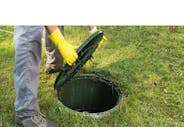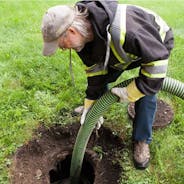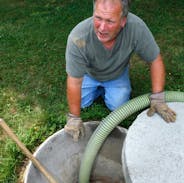© 2024/2025 AffordableSepticTankCleaningKentucky.com
All Rights Reserved
This site is not a part of the Facebook website or Facebook Inc.
Additionally, this site is NOT endorsed by Facebook in any way.
FACEBOOK is a trademark of FACEBOOK, Inc.
This site is not a part of Google™ website or network of sites such as
Youtube™ or any company owned by Google™ or Youtube™.
Additionally this website is not endorsed by Google™ Youtube™ Inc. in any way.
Google™ is a trademark for all their respective companies.

Proper care goes beyond periodic cleaning. Being mindful of what enters your septic system, avoiding harsh chemicals and excessive water use. Regularly cleaning the tank's filter and maintaining the drainfield area are also important steps in ensuring the longevity and efficiency of your household's wastewater treatment system.
Most septic professionals recommend having your septic tank pumped every 3 to 5 years to remove accumulated solids and sludge. This frequency may vary depending on factors like household size, water usage, and tank capacity. During a cleaning, professionals will remove the scum, sludge, and effluent from your tank using specialized pump trucks. They'll also inspect for leaks and assess the overall condition of your system.
Understanding Septic Systems
Septic systems are crucial for managing household wastewater in areas without centralized sewer systems. These on-site treatment facilities process and filter waste before releasing it safely back into the environment.
The main components of a septic system include the tank, baffles, and drainfield. Septic tanks, typically made of concrete or fiberglass, can hold over 1,000 gallons of waste. Inside, bacteria break down solids into sludge and scum layers.
Baffles prevent solids from entering outlet pipes, while allowing liquid effluent to flow into the drainfield. This leach field consists of perforated pipes that distribute wastewater into the soil for final treatment.
Regular tank pumping every 3-5 years removes accumulated sludge and scum. This maintenance is essential for preventing system failures and costly repairs.
We classify septic systems into several types based on soil conditions and site characteristics. Conventional systems use gravity to move effluent from the tank to the drainfield.
Alternative systems may include pumps, sand filters, or aerobic treatment units for sites with poor soil or high groundwater. Community cluster systems serve multiple homes, sharing a large drainfield.
Mound systems are used where the soil depth is limited. They pump effluent to an elevated drainfield built above the natural soil surface.
Each type has specific maintenance needs, but all require careful use to avoid overloading or introducing harmful substances that could disrupt the treatment process.
Proper septic tank cleaning involves specialized equipment, safety precautions, and a systematic approach. Regular maintenance is crucial for a well-functioning septic system.
Tank pumping is the primary method for cleaning septic tanks. We remove accumulated solids, sludge, and scum to prevent system overload. This process typically occurs every 3-5 years, depending on household size and usage.
During pumping, we open the tank lid and insert a large hose. The vacuum truck creates suction to extract waste. We ensure thorough removal by breaking up stubborn deposits.
Pumping maintains proper tank function and prevents backups. It also allows us to inspect the tank's interior for damage or potential issues.
The main tool for septic cleaning is the vacuum truck. It features a powerful pump and large holding tank. The truck's long hose reaches into the septic tank, even when it's not easily accessible.
Other essential equipment includes:
- Protective gear (gloves, boots, goggles)
- Tank locating tools
- Probes for measuring sludge levels
- Backflow preventers
- Pressure washers for cleaning filters
Modern vacuum trucks often have cameras for tank inspection. This technology helps identify problems without entering the tank.
Safety is paramount in septic tank cleaning. We always wear protective gear to guard against harmful gases and bacteria. Proper ventilation is crucial, as toxic gases can accumulate in the tank.
Key safety practices:
- Never enter a septic tank without proper training and equipment
- Use gas detectors to check for dangerous levels of methane or hydrogen sulfide
- Keep the work area clear of bystanders
- Wash hands and equipment thoroughly after cleaning
We also ensure the tank lid is secure after cleaning to prevent accidents. Proper disposal of pumped waste at approved facilities is essential for environmental safety.
Maintenance and Inspection
Regular upkeep and professional evaluations are crucial for a well-functioning septic system. Proper maintenance extends the lifespan of your tank and prevents costly repairs.
We recommend creating a maintenance schedule to keep your septic system in top shape. First, monitor water usage and avoid overloading the system. Fix any leaky faucets or running toilets promptly. Be mindful of what goes down the drain - avoid flushing non-biodegradable items or harsh chemicals.
Regularly inspect the area around your tank for signs of trouble, such as wet spots or foul odors. Keep accurate maintenance records, noting dates of inspections, pumping, and any repairs. This documentation is invaluable for tracking your system's health over time.
Consider installing an effluent filter to catch solid waste particles. These filters can significantly improve your system's performance and longevity.
We advise scheduling professional inspections every 1-2 years. A qualified technician will check for leaks, examine scum and sludge layers, and assess overall system health. They'll also determine the appropriate pumping frequency based on your household size and water usage.
During the inspection, the technician will:
- Measure tank levels
- Check inlet and outlet pipes
- Evaluate the drain field's condition
- Test system components
Professional assessments help catch minor issues before they become major problems. They also ensure your system complies with local regulations. After the inspection, review the report with the technician and discuss any recommended maintenance or repairs.
Best Practices for Septic System Care
Proper septic system maintenance is crucial for longevity and environmental protection. We'll explore key practices that optimize system performance and prevent costly repairs.
Conserving water is essential for septic system health. We recommend installing low-flow fixtures and fixing leaks promptly. Spread out laundry loads throughout the week to avoid overwhelming the system. Consider using high-efficiency washing machines and dishwashers.
Avoid running multiple water-intensive appliances simultaneously. Take shorter showers and turn off taps when not in use. These simple habits can significantly reduce water entering the septic tank, improving its efficiency.
We suggest installing water-saving devices on faucets and showerheads. These small investments can lead to substantial water savings over time, benefiting both your septic system and the environment.
What goes down your drains directly impacts septic system function. We advise using septic-safe toilet paper that breaks down easily. Avoid flushing non-biodegradable items like wipes, feminine hygiene products, or paper towels.
In the kitchen, refrain from pouring grease or oil down the sink. These substances can clog pipes and hinder bacterial breakdown in the tank. Use a grease trap or dispose of cooking oils in the trash.
We recommend composting food scraps instead of using garbage disposals. If you must use a disposal, limit its use to prevent overloading the septic tank with organic matter.
Harsh chemicals can disrupt the bacterial balance in septic tanks. We suggest using natural, septic-safe cleaning products. Vinegar and baking soda are effective alternatives for many household cleaning tasks.
Limit the use of antibacterial soaps and bleach. These can kill beneficial bacteria necessary for waste breakdown. Choose phosphate-free detergents to prevent nutrient overload in the leach field.
Consider adding natural bacteria boosters to your septic system. These products can enhance waste decomposition. However, a well-maintained system typically doesn't require additives. Regular pumping every 3-5 years is more crucial for system health.
Septic Tank Cleaning: Essential Maintenance for Home Waste Systems
Septic tanks play a crucial role in managing household wastewater for millions of homes not connected to municipal sewer systems. Regular cleaning and maintenance are essential to keep these systems functioning properly and prevent costly backups or environmental issues. The average cost to clean a septic tank ranges from $250 to $550, with most homeowners paying around $400.





